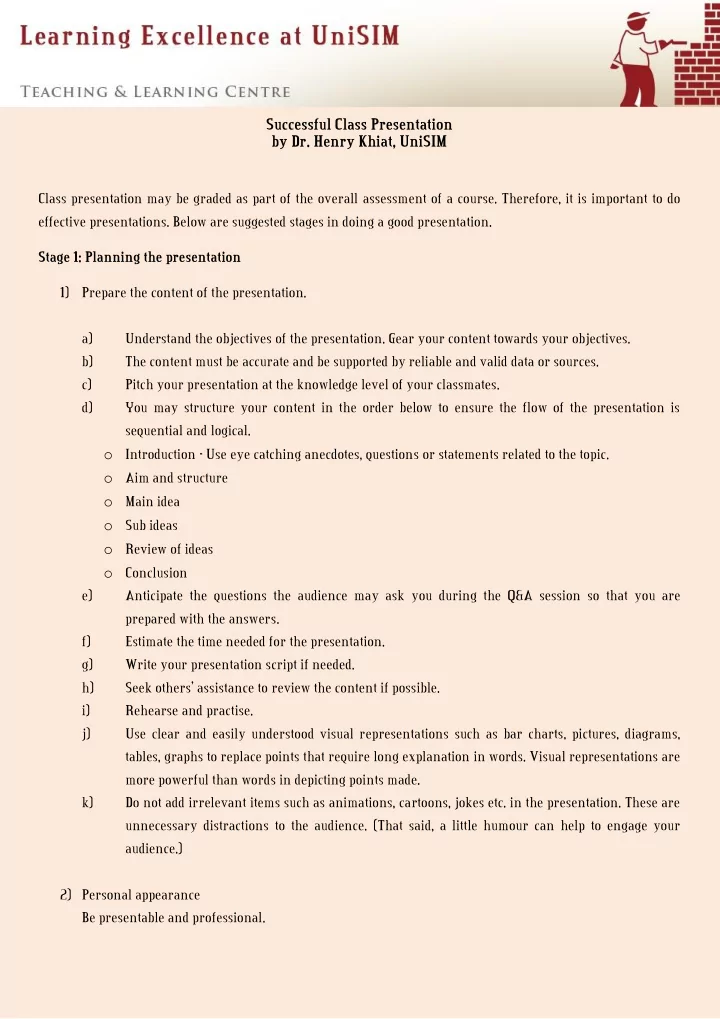

Successful Class Presentation by Dr. Henry Khiat, UniSIM Class presentation may be graded as part of the overall assessment of a course. Therefore, it is important to do effective presentations. Below are suggested stages in doing a good presentation. Stage 1: Planning the presentation 1) Prepare the content of the presentation. a) Understand the objectives of the presentation. Gear your content towards your objectives. b) The content must be accurate and be supported by reliable and valid data or sources. c) Pitch your presentation at the knowledge level of your classmates. d) You may structure your content in the order below to ensure the flow of the presentation is sequential and logical. o Introduction - Use eye catching anecdotes, questions or statements related to the topic. o Aim and structure o Main idea o Sub ideas o Review of ideas o Conclusion e) Anticipate the questions the audience may ask you during the Q&A session so that you are prepared with the answers. f) Estimate the time needed for the presentation. g) Write your presentation script if needed. h) Seek others’ assistance to review the content if possible. i) Rehearse and practise. j) Use clear and easily understood visual representations such as bar charts, pictures, diagrams, tables, graphs to replace points that require long explanation in words. Visual representations are more powerful than words in depicting points made. k) Do not add irrelevant items such as animations, cartoons, jokes etc. in the presentation. These are unnecessary distractions to the audience. (That said, a little humour can help to engage your audience.) 2) Personal appearance Be presentable and professional.
Stage 2: Delivering the presentation 1) If you are having presentation anxiety, try the following: a) Give yourself a pep talk to reassure yourself that you are going to do well in the presentation. b) Visualise that you are presenting to an audience who knows nothing about your content. c) Calm your breathing by taking in air deeply and slowly. d) Have some hot drinks before the presentation. 2) Do not appear as arrogant, insincere and overly casual in the eyes of the audience. Maintain a confident, friendly and relaxed attitude through the following: a) Speak clearly and audibly If the audience cannot hear you, they will lose interest in the presentation. b) Gesticulate naturally and moderately when speaking Be aware of your gestures that may arise because of anxiety. Try to curb them. c) Maintain eye contact Eye contact with individuals or sections of the audience should be maintained for a substantial amount of time like 2-5 seconds to allow them to notice that you are looking at them, but not long enough to make them uncomfortable. This allows you to gauge the interest level of the audience and engage them accordingly. d) Smile occasionally This can help you to create rapport with the audience. e) Watch your timing If your presentation is not paced properly, the latter part of your presentation will usually be rushed or incomplete. f) Be enthusiastic and energetic This can capture the attention of the audience easily. g) Stay focused on your presentation Do not sidetrack too much or else you may run out of time. h) Control your tone Emphasize, change your tone, or pause to allow important points to be captured by the audience. i) Deal with disruptive behaviours Move closer to any disrupting audience and ask if they need any clarification.
Stage 3: Questions and Answers There are certain pointers that you can follow during the Q & A session: 1) Listen attentively and repeat the question for the sake of the rest of the audience if needed. 2) Acknowledge feelings expressed by the audience. Do not get defensive. Acknowledge and empathize with the negative emotions the audience might have regarding your presentation. 3) Acknowledge the limitations in your presentation. Be humble to acknowledge that there are gaps in your presentation. 4) Offer to find out the required information later for the audience if you are unable to answer some of their questions. 5) Do not neglect the rest of the audience while answering a question.
Recommend
More recommend